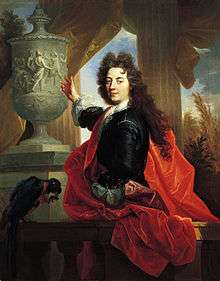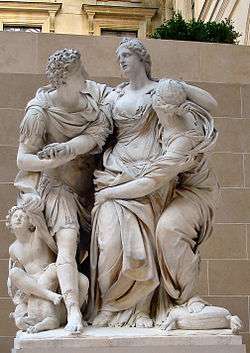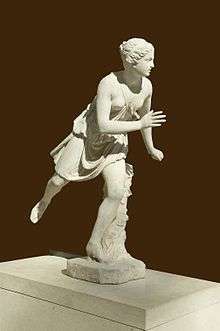Pierre Lepautre (sculptor)
Pierre Lepautre (4 March 1659 – 22 January 1744)[1] was a French sculptor, a member[2] of a prolific family of artists in many media, who were active in the 17th and 18th centuries. He was born and died in Paris.

He won the Prix de Rome, for study at the French Academy in Rome, where he was a pensionnaire' from 1683 to 1701. While in Rome he sent back to France a number of sculptures demonstrating his skill, among which were the Faune au chevreau of 1685, which went to ornament the gardens at Château de Marly.[3] Lepautre returned to Paris in 1701. His Atalante (1704) was also destined for Marly. From 1705 to 1710, he was occupied with decorative bas-reliefs and sculptures for the royal chapel of Versailles, under the artistic supervision of Jules Hardouin-Mansart: his are the colossal statues of Saint Ambrose and Saint Gregory.[4]
A retable in the form of a monumental gateway in the église de Saint-Eustache, Paris, illustrates the assumption of Saint Agnes.

His completion of the over-lifesize group of Arria et Pœtus (finished 1695) after the design begun by Jean-Baptiste Théodon proceeded too slowly[5] and Énée portant son père Anchise suivi d'Ascagne (signed and dated 1716), after François Girardon[6] demonstrated his facility and fidelity as an executant. The sculpture of Aeneas carrying Anchises was begun in Rome, where Lepautre made numerous terracotta bozzetti for it.[7] The sculpture gained renown for Lepautre: bronze reductions of it were made for collectors.[8] The 19th-century classicizing sculptor David d'Angers had one of Lepautre's designs for it, which was given by his widow to the museum in his native city.[9]
Pierre Lepautre preferred to become a member of the modest artists' Académie de Saint-Luc, for which he held a lifetime post as Rector, rather than try for the more prestigious Académie royale de peinture et de sculpture.
Notes
- Chalmers, Alexander (1815). The general biographical dictionary: containing an historical and critical account of the lives and writings of the most eminent persons in every nation, particularly the British and Irish, from the earliest accounts to the present time, Volume 24. Oxford University. p. 214.
- There is some confusion concerning the relationships in this family. Elaine Evans Dee, writing in the Dictionary of Art, says he is the son of Jean Le Pautre (1618–1682), a designer and engraver (who was the son of Adrien Le Pautre, a master joiner, who died in 1660), and the brother of Antoine Le Pautre (1621–1679), a well known architect (see "Le Pautre family [Le Paultre; Lepautre]", vol. 19, p. 210, in The Dictionary of Art, 1996). Françoise de La Moureyre, writing in the same dictionary, says he is the son of Jean Le Pautre (1622–1676), a master mason and building contractor [see "(3) Pierre Le Pautre II", vol. 19, p. 213, in The Dictionary of Art, 1996]. He was called the son of the architect Antoine Lepautre in Marie Nicolas Bouillet. Dictionnaire universel d'histoire et de géographie (1869), s.v. Lepautre".
- The group was in the Garden of the Tuileries when it was taken to the Musée du Louvre in 1872. It is one of three Lepautre sculptures formerly at Marly now displayed with the Atalante in the Cour Marly.
- Sculptures and decorative details in the Royal Chapel
- Arria et Caecinus Paetus was begun in 1685; Matthieu de La Teullière, Director of the Académie de France assigned it to Lepautre, who finished it in 1695.
- Left unfinished in Rome when he returned to France, it was shipped in 1715 and finished in Paris. Set up in the Tuileries Garden in 1717, where it remains (Geneviève Bresc-Bautier, Les Sculptures des jardins du Louvre, du Carrousel, et des Tuileries (Paris, 1986) vol. II:264-69).
- Mentioned in correspondence between Matthieu de La Teullière and the director of the Bâtiments du Roi, published in Anatole de Montaiglon, Correspondance des Directeurs de l'Académie de France à Rome avec les surintendants des bâtiments (vol. I, Paris, 1887), especially letters of 16 April and 31 July 1696 and 19 November 1697, noted in Bresc-Bautier 1986 and by Betsy Rosasco, "A Terracotta 'Aeneas and Anchises' attributed to Laurent Guiard", Record of the Art Museum, Princeton University 45.2 (1986:2-15); Rosasco notes the former misattribution to Lepautre of terracottas of this subject, based on references in the correspondence.
- A small bronze, formerly in the collection of Arnold Seligmann, Paris, is in the Art Gallery of Ontario.
- Henri Auguste Jouin,, Notice des peintures et sculptures du Musée d'Angers (Angers, 1870) "Annexe du Galerie David", no. 759, p. 238.
References
| Wikimedia Commons has media related to Pierre Lepautre. |
- Pierre Lepautre in American public collections, on the French Sculpture Census website
